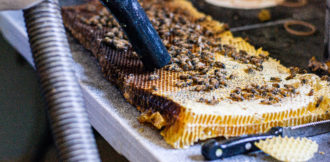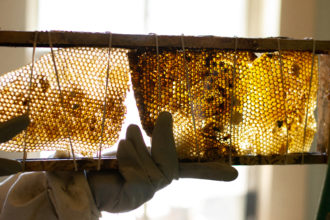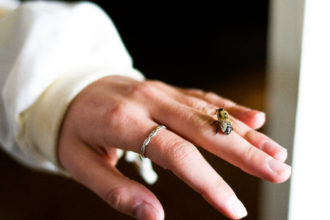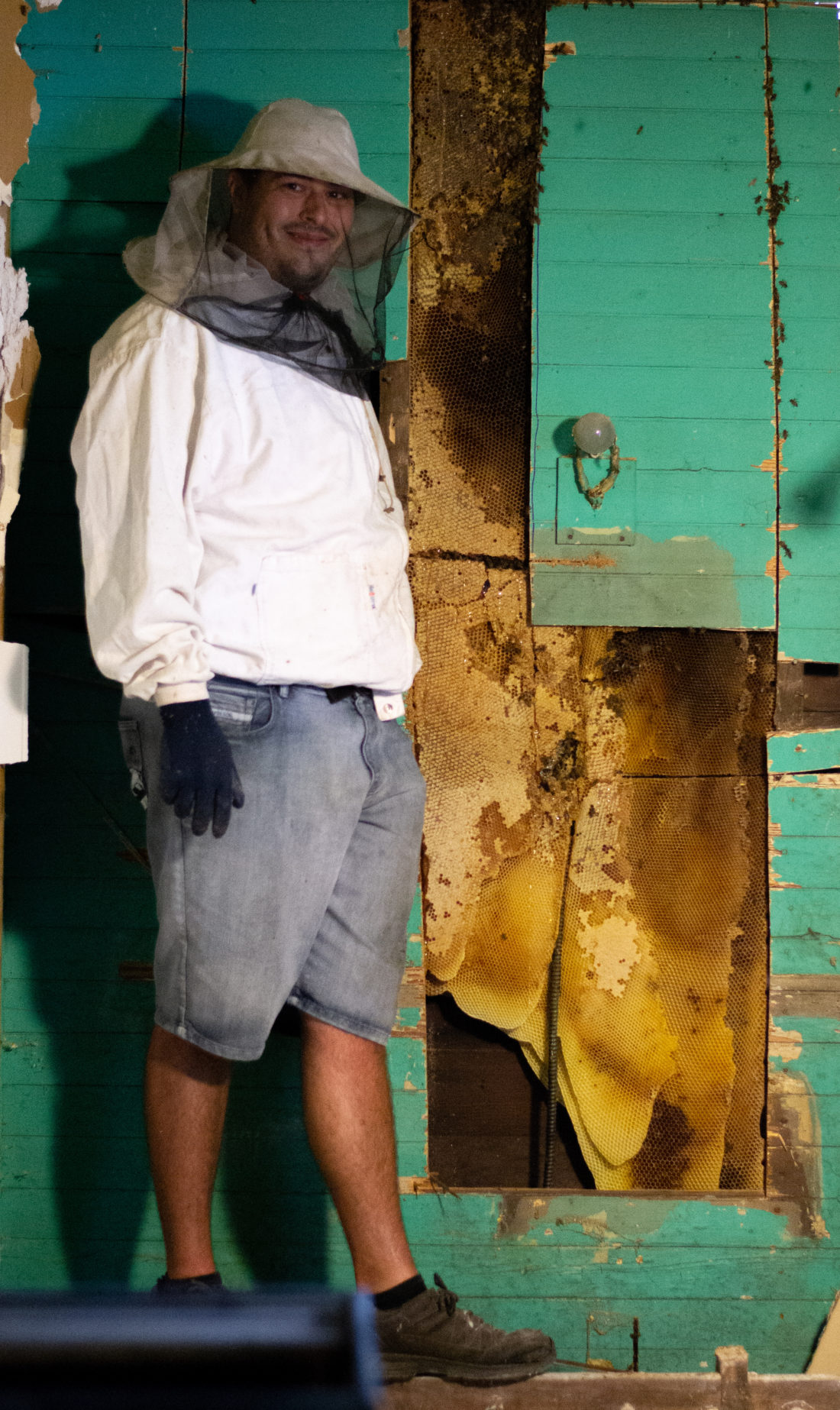This spring, Kate Prince became curious about the bees that frequented the backyard of her West Asheville home. For years, she says, “dense, football-shaped swarms” had gathered on a hawthorn across the street before making welcome visits to her flower gardens and trees.
One day, Prince decided to follow the swarm as it flew to a house with white, wooden siding. The bees quickly disappeared underneath the eaves, vanishing into a small crack in the woodwork. After contacting the house’s owner, who currently lives in Chicago, she found out two things: The house had been vacant for a number of years; and its owner vaguely recalled seeing a few bees occasionally crawl beneath the eaves when he lived there full time.
This wasn’t a few bees.
For assistance and advice, Prince contacted the Buncombe County Beekeepers Club. The beekeeper who responded estimated that each of the roiling hordes he removed over multiple visits contained as many as 20,000 bees. After repeatedly dealing with swarms of this size, the beekeeper suggested trying to find and relocate the hive.
That task was easier said than done, but local beekeepers Brandon and Kimberly Delcambre were up to the challenge. Together, the two operate Couple of Bees, a hive relocation and management service.
The house’s owner mailed Prince a key, and the Delcambres were soon donning beekeeping suits as they prepared to enter the house. Not to be left out, Prince, who owns Kate Prince Photography, fetched her camera and followed them in.
Digging for gold
“The air inside was musty,” Prince recalls, “but I got a strange feeling that the walls were alive.” It was clear from an ever-present buzzing that the vacant house was, in fact, occupied.
Brandon scanned the walls with a thermal camera, revealing a heat signature behind the bathroom wall that told him where the nest was. He began to cut the drywall by hand, eschewing power tools to avoid making aggressive vibrations that would agitate the hive. The Delcambres also used smoke to keep the bees calm.
As the wall opened, it became clear that this hive was something special. “The room was stale, but as he cut, it filled with the most fragrant smell of honey,” says Prince.
Behind the wall were layers upon layers of glowing honeycomb. Rounded, amber-hued stalactites crawled with nearly 5 million bees. “It was humbling,” Prince says.
Hive mind

The Delcambres relocate beehives about once every other week during spring and summer. Hives often appear when small groups of bees splinter from existing nests. In these cases, the groups will raise their own queens and move away to relieve the negative effects of high population density.
If bees move into a house, the Delcambres recover the hives and take them to their own property, where they have several established hives. Typically, says Brandon, the hives they remove are small; at the larger end of the usual scale, they can reach 5 feet tall.
“It was the biggest hive I’ve ever seen,” says Brandon about what he uncovered in West Asheville. “I’m about 6 foot 1 [inch tall], and I was standing next to it — it had to be at least 7 feet tall. It’s been there for at least 10 years.”
Once the hive was exposed, the Delcambres went to work using a specially designed bee vacuum. Brandon explains that the suction can be adjusted to avoid harming the bees, and the vaccum’s interior contains ramps and floors for the captives to explore.
“I cut parts of the comb and remove the bees from it. My wife then determines which parts of the comb house babies versus which ones are holding honey,” Brandon says about the process. “She will then cut the comb to size and fit it into frames that will go into hives we have back at the house. That way, we can rebuild the colony with its original babies and its original food.”
Welcome to the neighborhood
Why do honeybees colonize houses?

Like all bees, the honeybee is part of the order Hymenoptera, which also includes wasps and ants. Most of these species build nests on the ground, but the honeybee is craftier: it’s evolved to nest in hollow, protective spaces.
“A house is basically a dead tree,” says Robert Zinna, an entomologist at Mars Hill University. “For bees adapted to live in cavities, interstitial spaces in houses almost perfectly mimic their natural habitat.”
For bees, a house often provides a haven that may be even better than a tree. The spaces between walls can be safer and more protected from the elements. And the European honeybees most commonly seen in Western North Carolina descend from domesticated bees released by immigrants to North America in the 1600s, notes Zinna, meaning they don’t show much of a fear response to humans.
But while honeybees generally aren’t dangerous outside of allergic reactions or children kicking a nest, wax and honey will cause structural damage to a house over time if allowed to persist. “We typically find hives either inside the walls between the studs or between stories, tucked in between floor joists. All they need is a three-eighths-inch gap, and they can use that for an entrance and exit,” Brandon Delcambre says. “Within a month, you could have a 3-foot hive.”
Buzzing along

After the removal, the Delcambres relocated the West Asheville bees to their own property. The addition brings them to a grand total of 15 hives, up substantially from the five-10 hives they usually house at any given time. Brandon says the bees are healthy and have adjusted well to their new home.
Bee populations are in decline nationwide for many reasons, including widespread pesticide use and the parasitic varroa mite. The good news, Brandon says, is that awareness of this plight is making hive relocation a more common method of handling bee infestations. “Most of our business comes from referrals from pest control companies,” he explains.
Preservation of bee species is crucial to human survival given their role as pollinators, making the Delcambres’ job even more important. According to the nonprofit Pollinator Partnership, which promotes National Pollinator Week June 22-28, a third of all food and beverages rely on pollinators, an estimated $20 billion worth of products in the U.S. alone.
Brandon knows this and treats the bees with respect, no matter how much work it takes to maintain the health of his hives — or even how much they may sting. “I’ve come to feel really calm around them,” he says. “If they sting me, it’s usually only about 10 stings in total [at a time]. It doesn’t bother me much anymore.”



Before you comment
The comments section is here to provide a platform for civil dialogue on the issues we face together as a local community. Xpress is committed to offering this platform for all voices, but when the tone of the discussion gets nasty or strays off topic, we believe many people choose not to participate. Xpress editors are determined to moderate comments to ensure a constructive interchange is maintained. All comments judged not to be in keeping with the spirit of civil discourse will be removed and repeat violators will be banned. See here for our terms of service. Thank you for being part of this effort to promote respectful discussion.